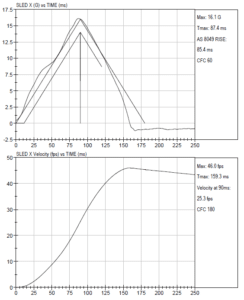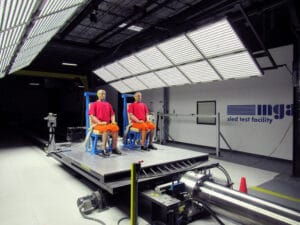
Commercial aircrafts required pulse per 14 CFR 25.562
MGA has been at the forefront of crash testing simulations in the aircraft industry for over 40 years. Working alongside airframe manufactures and their suppliers as safety regulations improve, our labs have assisted seat and seat belt manufacturers to conduct tests on safety harnesses, as well as airbag integrated systems for aircrafts.
A safety harness is a form of safety mechanism that helps restrain a person/object to prevent injury/damage during an accident. Safety harnesses are crucial components to occupants' protection and crashworthiness. Mandatory during taxi, take-off, and landing, belts and seats are evaluated both statically and dynamically as independent components and complete systems. With years of experience in harness evaluation, MGA conducts dynamic, static, and environmental tests to assist with their development & certifications.
As a part of an aircraft interior retrofit, seat manufacturers often change seat belts and other safety mechanisms. A popular methodology to dynamically certify these new seat-belts is by a comparison with the current certified seat-belt. This is accomplished by using two identical steel/rigid seats side by side and simulating a crash at the required pulse depending of the aircraft type. The occupants’ head trajectory and the forces acted on the seat belt are then compared to the recommendations set by regulatory bodies. This method is approved in FAA memorandum ANM-115-05-10. Following guidelines set aside by the Aerospace Standard 8043B, the seat belts are additionally tested in a quasi-static environment. This is done by applying the seat belt to a rigid body-block, which in turn gets pulled to simulate the loads seen during a crash.

With the implementation of evolving airbag technology, manufacturers are better able to protect front row passengers from contact with any rigid structure such as bulkheads and galleys. Airbags are typically used on a front seat of an airplane. In the event of retrofitting an airbag outfitted harness, MGA is able to fire the airbags in static and dynamic environment for comparison. This method would be identical to the prior.
MGA has a history of working successfully with OEMs and their suppliers on aircraft safety testing. As this industry continues to grow and new safety guidelines are implemented, we will continue to honor our commitment to supporting our customers in the development of the next generation of seats and interiors.

